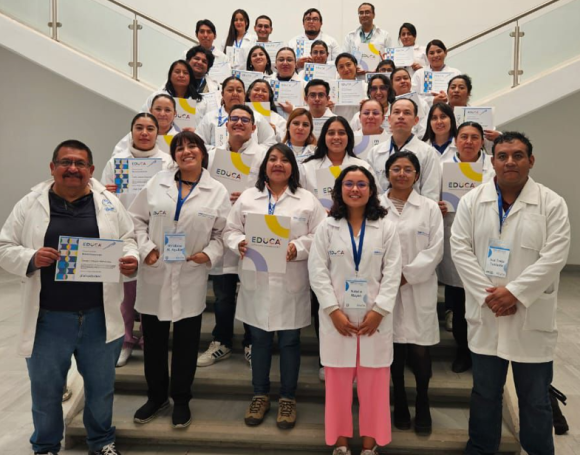After a successful pilot and first year of the program, ABE Mexico has exciting plans for expansion, with a similar focus as South Africa and Brazil on community-building. Earlier this year, they incorporated ABE students and curricula into their entrepreneurship fair. This Mexico City fair has been running for 6 years to highlight student work in finance and entrepreneurship; this year it featured biotechnology for the first time, and about 50 ABE students participated by setting up a booth to demonstrate knowledge gained from the ABE labs and to engage other students and their families in hands-on activities and games.
“This was a very good experience for students to show off their work with ABE,” says Monica Georgina Cinco Basurto of ABE Mexico. “And this fair was very important because students visited from Morelos, a different state.” The event went so well that they plan to invite 100 students in the upcoming year to run an ABE booth again at the same fair and to continue to include students from other states. With student interest from other areas, the hope is that ABE will expand to new regions in Mexico.

For the upcoming school year, the program is opening two new sites in Yucatan and Hidalgo to expand access to students, having signed an agreement with Universidad Politécnica Metropolitana de Hidalgo, about 2 hours from Mexico City, and with an agreement in the works with Universidad Autónoma de Yucatán in Southern Mexico. The program has already reached more than 2,000 students in five states.
Interest among science teachers in the region is high, says Andrea Flamand, also at Fundación EDUCA México, though there is some initial trepidation. “First, the teachers need to really understand what it's about,” she says. “But when you start speaking with them, and they understand all the support that they will get from the Mexico site, they are very happy to participate.”
One key lesson they have learned along the way is the importance of laying some scientific groundwork at the middle school level. While the teachers understand the biotech concepts and material well after their professional development training, many middle school students do not have the foundational knowledge to fully appreciate the ABE labs. “So, what we are doing in this middle school year is having two or three sessions before the labs where teachers can explain better to the students the purpose of each lab and how biotech is part of our daily life,” Cinco Basurto says. “We are reinforcing the concepts before the labs so that when they have the experience doing the experiments, they can be more clear about the use of biotech.”

At the high school level, ABE Mexico is already seeing the impact of the ABE labs through students’ greater enthusiastic about the sciences. They are planning to implement the complete lab sequence soon with high school students and at the university level.
Meanwhile, they are grateful to be part of the broader STEM education community, including through their participation in the recent D.C.-area conference with ABE sites in Brazil and South Africa. Says Cinco Basurto: “It was an amazing experience to share ideas at an international event, and we are so proud to be part of this program.”
Read Part 1 of this series, Building Bridges in Brazil.
Read Part 2 of this series, Growing Community in South Africa.
